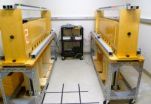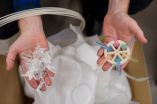(Press-News.org) ROSEMONT, Ill.–A new study appearing in the March issue of the Journal of Bone and Joint Surgery (JBJS) showed that women with distal radius (wrist) fractures had decreased strength compared to similar patients without fractures. This could explain why these women were more likely to fall and might sustain future fractures.
The investigators used a variety of balance and strength tests combined with patient-provided information about walking habits to evaluate the physical performance and risk of falls for post-menopausal women with and without previous wrist fractures. Wrist fractures are the most common upper-extremity fractures in older women, but little is known about what factors contribute to the risk of falls for these patients.
Although overall physical performance level was found to be no different between women with and without wrist fractures, differences in the results of two of the strength tests – chair stand (the ability to rise from a chair) and grip strength – may imply an early subtle decrease in physical ability in the patients with wrist fractures.
"Differences in chair stand test scores and grip strength may imply an early subtle decrease in physical performance level in patients with a distal radial fracture. Further studies are warranted on whether preventative measures such as muscle strengthening exercise would be helpful for preventing future fall events and fractures in patients with previous distal radial fracture," reports study author and orthopaedic surgeon Hyun Sik Gong, MD.
In a companion commentary in JBJS Perspectives, orthopaedic surgeon Leon Benson, MD, writes, "At a very basic level, this paper (Gong et al.) helps start to answer the 'why' of fragility fractures and identifies a few clues that might confirm what everyone, both doctors and patients, suspect is true: physical activity is the holy grail of orthopaedic health."
Specific Study Details
The study involved 80 post-menopausal women over age fifty, 40 of whom had fractured their wrist by falling on an outstretched hand. The control group consisted of 40 women with other, unilateral (on one side) upper extremity conditions such as carpal tunnel syndrome, tenosynovitis (inflammation of the sheath that surrounds a tendon), or epicondylitis (tennis elbow).
The physical performance of the participants was evaluated using the Short Physical Performance Battery, grip strength and the participant's self-estimated amount of time per day that they spent walking.
The Short Physical Performance Battery consisted of standing balance and walking speed and the chair stand (measured by having the participant repeatedly stand up and sit down as quickly as possible and measuring the speed).
Key Study Findings
No significant differences were found in the Short Physical Performance Battery summary score and walking hours per day between the patient group and the control group.
The patient group had a significantly lower score for the chair stand and grip strength tests than the control group.
No significant differences were found in other potential fall risk factors between the two groups.
Both the study authors, and the author of the related commentary note that given the frequency, health risks and expense associated with falls for older adults, continued study to determine the causes of falls and any modifiable risks should be a priority.
INFORMATION:
Disclosure: One or more of the authors received payments or services, either directly or indirectly (i.e. via his or her institution), from a third party in support of an aspect of this work. None of the authors, or their institution(s), have had any financial relationship, in the thirty-six months prior to submission of this work, with any entity in the biomedical arena that could be perceived to influence or have the potential to influence what is written in this work. Also, no author has had any other relationships, or has engaged in any other activities, that could be perceived to influence or have the potential to influence what is written in this work. The complete Disclosures of Potential Conflicts of Interest submitted by authors are always provided with the online version of this article.
Learn more about wrist fracture, and what it may mean for post-menopausal women.
Download the Falls Awareness and Prevention Guide
AAOS on Facebook and Twitter
Study aims to define risk factors for falls in post-menopausal women
Strength test results may be early indicator of decreased physical performance
2014-03-05
ELSE PRESS RELEASES FROM THIS DATE:
UF researchers find drug therapy that could eventually reverse memory decline in seniors
2014-03-05
GAINESVILLE, Fla. — It may seem normal: As we age, we misplace car keys, or can't remember a name we just learned or a meal we just ordered. But University of Florida researchers say memory trouble doesn't have to be inevitable, and they've found a drug therapy that could potentially reverse this type of memory decline.
The drug can't yet be used in humans, but the researchers are pursuing compounds that could someday help the population of aging adults who don't have Alzheimer's or other dementias but still have trouble remembering day-to-day items. Their findings will ...
NASA sees Tropical Cyclone Faxai stretching out
2014-03-05
When a tropical cyclone becomes elongated it is a sign the storm is weakening. Imagery from NASA-NOAA's Suomi NPP satellite today revealed that wind shear was stretching out Tropical Cyclone Faxai and the storm was waning.
On March 5 at 1500 UTC/10 a.m. EST, Tropical Cyclone Faxai's center was located near 22.5 south and 155.2 east, about 699 nautical miles/804.4 miles/ 1,295 km west-northwest of Wake Island. According to the Joint Typhoon Warning Center or JTWC, Faxai's maximum sustained surface winds dropped to 50 knots/57.5 mph/92.6 kph. Faxai was moving to the northeast ...
UCSB study explores cocaine and the pleasure principle
2014-03-05
(Santa Barbara, Calif.) — On the other side of the cocaine high is the cocaine crash, and understanding how one follows the other can provide insight into the physiological effects of drug abuse. For decades, brain research has focused on the pleasurable effects of cocaine largely by studying the dopamine pathway. But this approach has left many questions unanswered.
So the Behavioral Pharmacology Laboratory (BPL) at UC Santa Barbara decided to take a different approach by examining the motivational systems that induce an animal to seek cocaine in the first place. Their ...
First-ever 3D image created of the structure beneath Sierra Negra volcano
2014-03-05
The Galápagos Islands are home to some of the most active volcanoes in the world, with more than 50 eruptions in the last 200 years. Yet until recently, scientists knew far more about the history of finches, tortoises, and iguanas than of the volcanoes on which these unusual fauna had evolved.
Now research out of the University of Rochester is providing a better picture of the subterranean plumbing system that feeds the Galápagos volcanoes, as well as a major difference with another Pacific Island chain—the Hawaiian Islands. The findings have been published in the Journal ...
Brain circuits multitask to detect, discriminate the outside world
2014-03-05
Imagine driving on a dark road. In the distance you see a single light. As the light approaches it splits into two headlights. That's a car, not a motorcycle, your brain tells you.
A new study found that neural circuits in the brain rapidly multitask between detecting and discriminating sensory input, such as headlights in the distance. That's different from how electronic circuits work, where one circuit performs a very specific task. The brain, the study found, is wired in way that allows a single pathway to perform multiple tasks.
"We showed that circuits in the ...
Similarity breeds proximity in memory, NYU researchers find
2014-03-05
Researchers at New York University have identified the nature of brain activity that allows us to bridge time in our memories. Their findings, which appear in the latest issue of the journal Neuron, offer new insights into the temporal nature of how we store our recollections and may offer a pathway for addressing memory-related afflictions.
"Our memories are known to be 'altered' versions of reality, and how time is altered has not been well understood," said Lila Davachi, an associate professor in NYU's Department of Psychology and Center for Neural Science and the ...
Are bilingual kids more open-minded?
2014-03-05
This news release is available in French. Montreal, March 5, 2014 — There are clear benefits to raising a bilingual child. But could there be some things learning a second language doesn't produce, such as a more open-minded youngster?
New research from Concordia University shows that, like monolingual children, bilingual children prefer to interact with those who speak their mother tongue with a native accent rather than with peers with a foreign accent.
The study, published in the journal Frontiers in Psychology and co-authored by psychology professors Krista ...
Save money and the planet: Turn your old milk jugs into 3D printer filament
2014-03-05
Making your own stuff with a 3D printer is vastly cheaper than what you'd pay for manufactured goods, even factoring in the cost of buying the plastic filament.
Yet, you can drive the cost down even more by making your own filament from old milk jugs. And, while you are patting yourself on the back for saving 99 cents on the dollar, there's a bonus: you can feel warm and fuzzy about preserving the environment.
A study led by Joshua Pearce of Michigan Technological University has shown that making your own plastic 3D printer filament from milk jugs uses less energy—often ...
Seeking quantum-ness: D-Wave chip passes rigorous tests
2014-03-05
With cutting-edge technology, sometimes the first step scientists face is just making sure it actually works as intended.
The USC Viterbi School of Engineering is home to the USC-Lockheed Martin Quantum Computing Center (QCC), a super-cooled, magnetically shielded facility specially built to house the first commercially available quantum computing processors – devices so advanced that there are only two in use outside the Canadian lab where they were built: The first one went to USC and Lockheed Martin, and the second to NASA and Google.
Since USC's facility opened ...
Calcium and vitamin D improve cholesterol in postmenopausal women
2014-03-05
CLEVELAND, Ohio (March 5, 2014)—Calcium and vitamin D supplements after menopause can improve women's cholesterol profiles. And much of that effect is tied to raising vitamin D levels, finds a new study from the Women's Health Initiative (WHI) just published online in Menopause, the journal of The North American Menopause Society (NAMS).
Whether calcium or vitamin D can indeed improve cholesterol levels has been debated. And studies of women taking the combination could not separate the effects of calcium from those of vitamin D on cholesterol. But this study, led by NAMS ...
LAST 30 PRESS RELEASES:
Making lighter work of calculating fluid and heat flow
Normalizing blood sugar can halve heart attack risk
Lowering blood sugar cuts heart attack risk in people with prediabetes
Study links genetic variants to risk of blinding eye disease in premature infants
Non-opioid ‘pain sponge’ therapy halts cartilage degeneration and relieves chronic pain
AI can pick up cultural values by mimicking how kids learn
China’s ecological redlines offer fast track to 30 x 30 global conservation goal
Invisible indoor threats: emerging household contaminants and their growing risks to human health
Adding antibody treatment to chemo boosts outcomes for children with rare cancer
Germline pathogenic variants among women without a history of breast cancer
Tanning beds triple melanoma risk, potentially causing broad DNA damage
Unique bond identified as key to viral infection speed
Indoor tanning makes youthful skin much older on a genetic level
Mouse model sheds new light on the causes and potential solutions to human GI problems linked to muscular dystrophy
The Journal of Nuclear Medicine ahead-of-print tip sheet: December 12, 2025
Smarter tools for peering into the microscopic world
Applications open for funding to conduct research in the Kinsey Institute archives
Global measure underestimates the severity of food insecurity
Child survivors of critical illness are missing out on timely follow up care
Risk-based vs annual breast cancer screening / the WISDOM randomized clinical trial
University of Toronto launches Electric Vehicle Innovation Ontario to accelerate advanced EV technologies and build Canada’s innovation advantage
Early relapse predicts poor outcomes in aggressive blood cancer
American College of Lifestyle Medicine applauds two CMS models aligned with lifestyle medicine practice and reimbursement
Clinical trial finds cannabis use not a barrier to quitting nicotine vaping
Supplemental nutrition assistance program policies and food insecurity
Switching immune cells to “night mode” could limit damage after a heart attack, study suggests
URI-based Global RIghts Project report spotlights continued troubling trends in worldwide inhumane treatment
Neutrophils are less aggressive at night, explaining why nighttime heart attacks cause less damage than daytime events
Menopausal hormone therapy may not pose breast cancer risk for women with BRCA mutations
Mobile health tool may improve quality of life for adolescent and young adult breast cancer survivors
[Press-News.org] Study aims to define risk factors for falls in post-menopausal womenStrength test results may be early indicator of decreased physical performance



